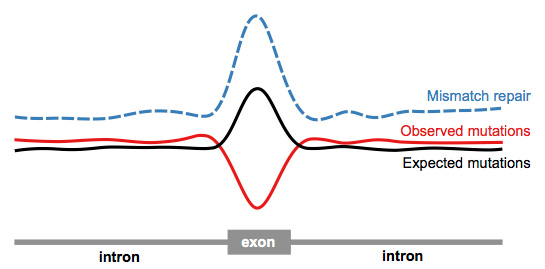This work reveals that the mechanism that repairs errors in DNA is more efficient in the regions of genes that hold information for the production of proteins.
The basic structure of genes is divided into exons and introns. The former holds the genetic sequences required to synthesize proteins, while most of the sequence of the latter hold less important information.
When DNA is copied, the molecule called polymerase—responsible for replication—places one nucleotide after the other in the sister sequence following the original sequence, but from time to time the wrong nucleotide is incorporated, thus causing an error. These errors can be corrected by the DNA mismatch repair machinery.
We showed that in tumors, with functional DNA mismatch repair machinery, exonic regions exhibit lower number of somatic mutations than expected. This decrease is not due to purifying selection. Instead, it can be explained by the enhanced activity of mismatch repair in exons compared to introns, a fact demonstrated by the lack of decrease in a type of paediatric brain cancer characterised by bialellic mismatch repair deficiency. The results of this work also suggest that the enhanced activity of mismatch repair in exons may be driven by the higher exonic levels of histone marks (H3K36me3).
Mismatch repair system is conserved across evolution, which leads to the intriguing possibility that a combination of enhanced repair and purifying selection contributes to the observed lower exonic variation and divergence, both intra and inter-species. This has important implications for designing methods to study genic selection and for our understanding of the evolution of eukaryotic genes.
Reference
